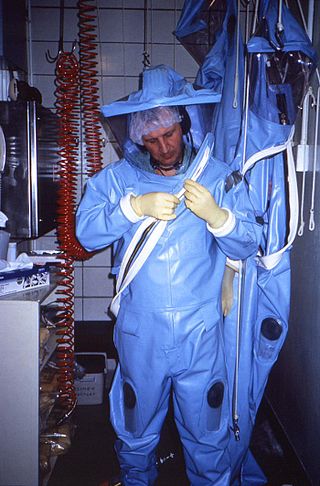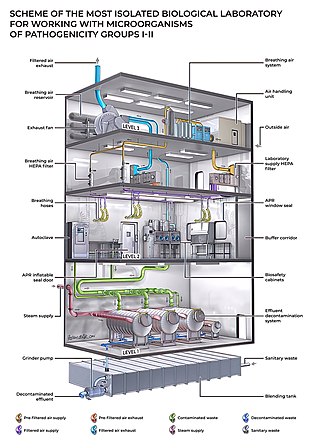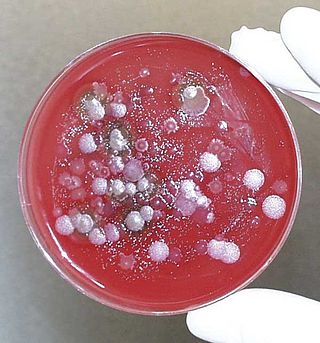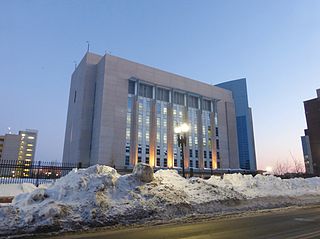Related Research Articles

Bioterrorism is terrorism involving the intentional release or dissemination of biological agents. These agents include bacteria, viruses, insects, fungi, and/or their toxins, and may be in a naturally occurring or a human-modified form, in much the same way as in biological warfare. Further, modern agribusiness is vulnerable to anti-agricultural attacks by terrorists, and such attacks can seriously damage economy as well as consumer confidence. The latter destructive activity is called agrobioterrorism and is a subtype of agro-terrorism.

Biosafety is the prevention of large-scale loss of biological integrity, focusing both on ecology and human health. These prevention mechanisms include the conduction of regular reviews of biosafety in laboratory settings, as well as strict guidelines to follow. Biosafety is used to protect from harmful incidents. Many laboratories handling biohazards employ an ongoing risk management assessment and enforcement process for biosafety. Failures to follow such protocols can lead to increased risk of exposure to biohazards or pathogens. Human error and poor technique contribute to unnecessary exposure and compromise the best safeguards set into place for protection.
Biosecurity refers to measures aimed at preventing the introduction and/or spread of harmful organisms intentionally or unintentionally outside their native range and/or within new environments. In agriculture, these measures are aimed at protecting food crops and livestock from pests, invasive species, and other organisms not conducive to the welfare of the human population. The term includes biological threats to people, including those from pandemic diseases and bioterrorism. The definition has sometimes been broadened to embrace other concepts, and it is used for different purposes in different contexts.
Biodefense refers to measures to counter biological threats, reduce biological risks, and prepare for, respond to, and recover from bioincidents, whether naturally occurring, accidental, or deliberate in origin and whether impacting human, animal, plant, or environmental health. Biodefense measures often aim to improve biosecurity or biosafety. Biodefense is frequently discussed in the context of biological warfare or bioterrorism, and is generally considered a military or emergency response term.

A biosafety level (BSL), or pathogen/protection level, is a set of biocontainment precautions required to isolate dangerous biological agents in an enclosed laboratory facility. The levels of containment range from the lowest biosafety level 1 (BSL-1) to the highest at level 4 (BSL-4). In the United States, the Centers for Disease Control and Prevention (CDC) have specified these levels in a publication referred to as BMBL. In the European Union, the same biosafety levels are defined in a directive. In Canada the four levels are known as Containment Levels. Facilities with these designations are also sometimes given as P1 through P4, as in the term P3 laboratory.

A biological hazard, or biohazard, is a biological substance that poses a threat to the health of living organisms, primarily humans. This could include a sample of a microorganism, virus or toxin that can adversely affect human health. A biohazard could also be a substance harmful to other living beings.

Glanders is a contagious zoonotic infectious disease that occurs primarily in horses, mules, and donkeys. It can be contracted by other animals, such as dogs, cats, pigs, goats, and humans. It is caused by infection with the bacterium Burkholderia mallei.

Biological weapons are pathogens used as weapons. In addition to these living or replicating pathogens, toxins and biotoxins are also included among the bio-agents. More than 1,200 different kinds of potentially weaponizable bio-agents have been described and studied to date.

The State Research Center of Virology and Biotechnology VECTOR, also known as the Vector Institute, is a biological research center in Koltsovo, Novosibirsk Oblast, Russia. It has research facilities and capabilities for all levels of biological hazard, CDC levels 1–4. It is one of two official repositories for the now-eradicated smallpox virus, and was part of the system of laboratories known as the Biopreparat.

The United States Army Medical Research Institute of Infectious Diseases is the U.S Army's main institution and facility for defensive research into countermeasures against biological warfare. It is located on Fort Detrick, Maryland, near Washington, D.C., and is a subordinate lab of the United States Army Medical Research and Development Command (USAMRDC), headquartered on the same installation.
Under United States law, Biological select agents or toxins (BSATs)—or simply select agents for short—are bio-agents which have been declared by the U.S. Department of Health and Human Services (HHS) or by the U.S. Department of Agriculture (USDA) to have the "potential to pose a severe threat to public health and safety". The agents are divided into (1) HHS select agents and toxins affecting humans; (2) USDA select agents and toxins affecting agriculture; and (3) overlap select agents and toxins affecting both.

One use of the concept of biocontainment is related to laboratory biosafety and pertains to microbiology laboratories in which the physical containment of pathogenic organisms or agents is required, usually by isolation in environmentally and biologically secure cabinets or rooms, to prevent accidental infection of workers or release into the surrounding community during scientific research.

The National Emerging Infectious Diseases Laboratories (NEIDL), is a biosciences facility of Boston University located on Albany street, within the clinical and biopharma hub of the South End neighborhood of Boston, Massachusetts.

Signed into effect on 12 June 2002, the Public Health Security and Bioterrorism Preparedness and Response Act of 2002 (PHSBPRA) was signed by the President, the Department of Health and Human Services (DHHS) and the U.S. Department of Agriculture (USDA).
The National Biodefense Analysis and Countermeasures Center (NBACC) is a government biodefense research laboratory created by the U.S. Department of Homeland Security (DHS) and located at the sprawling biodefense campus at Fort Detrick in Frederick, MD, USA. The NBACC is the principal U.S. biodefense research institution engaged in laboratory-based threat assessment and bioforensics. NBACC is an important part of the National Interagency Biodefense Campus (NIBC) also located at Fort Detrick for the US Army, National Institutes of Health and the US Department of Agriculture.
BioSense is a program of the Centers for Disease Control and Prevention (CDC) that tracks health problems as they evolve and provides public health officials with the data, information and tools they need to better prepare for and coordinate responses to safeguard and improve the health of the American people.

The Galveston National Laboratory (GNL) in Galveston, Texas, United States, is a high security National Biocontainment Laboratory housing several Biosafety level 4 research laboratories. The lab is run by the University of Texas Medical Branch (UTMB) for exotic disease diagnosis and research. The GNL is one of the 15 biosecurity level 4 facilities in the United States and the largest one in the world located on an academic campus.
Biosecurity in the United States is governed by the Bureau of Western Hemisphere Affairs, which is part of the US Department of State. It obtains guidance and advice on specific matters relating to biosecurity from various other government agencies.
Sanitary epidemiological reconnaissance, synonym epidemiological reconnaissance is a literal name of a concept and routine of finding out disease potential on a territory of arrival of major contingent. Russian: санитарно-эпидемиологическая разведка, син. эпидемиологическая разведка. This is a kind of medical reconnaissance, process of information gathering on possible infectious diseases' origin-sources, the ways and factors of the infection transfer and determining all conditions that could have promoted the spread of infestation among army service personnel. In 1939 Academician E.N.Pavlovsky announced his "doctrine of nidality", so called by Soviet biologists. People can acquire zoonoses and insect-borne diseases when they occupy at certain times of the year natural habitat of a certain pathogen. The WHO Expert Committee on Zoonoses listed over 100 such diseases. About natural focality of the diseases is known elsewhere.
The United States Biological Defense Program—in recent years also called the National Biodefense Strategy—refers to the collective effort by all levels of government, along with private enterprise and other stakeholders, in the United States to carry out biodefense activities.
References
- ↑ Cieslak, Theodore J. and George W. Christopher (2007), "Medical Management of Potential Biological Casualties: A Stepwise Approach", In: Dembek, Zygmunt F. (2007), Medical Aspects of Biological Warfare Archived 2012-08-27 at the Wayback Machine , (Series: Textbooks of Military Medicine), Washington, DC: The Borden Institute, pg 457.